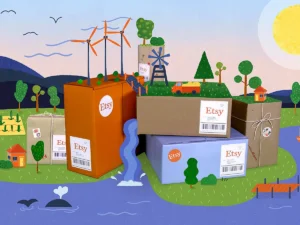While Earth Day brings our environmental responsibilities into sharp focus, the truth is that sustainability demands brands’ attention every day. From sourcing to packaging to managing logistics, the aim is clear: build an ecosystem that’s beneficial for the planet, profitable for businesses and positive for consumers.
A 2023 report by ThredUp found that 78% of consumers prefer to buy from brands that are transparent about sustainability efforts. This means sustainability is no longer a niche concern—it’s an expectation.
So, ready to get your green on? Let’s dive into 5 ideas to steer your business towards a greener future.
1. Eco-Friendly Packaging Solutions

Transitioning to sustainable packaging effectively reduces environmental footprints. TerraCycle, a waste management company that operates as a B2B service provider, runs the Loop program which collaborates with major brands to offer durable reusable packaging solutions reducing reliance on single-use plastics. Similarly, Amazon has reduced single-use plastics in favor of recyclable packaging and shares its sustainable packaging technology to help other companies meet their net-zero targets. These efforts not only contribute to environmental conservation but also align with growing consumer demand for sustainable practices.
2. Sustainable Sourcing and Production

Prioritizing sustainability in sourcing and production is essential. Allbirds leads with innovations like the M0.0NSHOT, a zero-carbon shoe, and aims to cut its product carbon footprint by 50% by the end of 2025. Businesses can follow by auditing supply chains, investing in sustainable materials and promoting transparency to build trust. Circular economy practices, like recycling and reusing, further strengthen sustainability efforts.
3. Carbon Neutral Shipping Options

Businesses can mitigate the environmental impact of shipping through various strategies. Etsy, for example, offsets 100% of its shipping-related emissions and aims for net-zero emissions by 2030. Companies can adopt similar practices by partnering with carbon offset programs, optimizing logistics and offering eco-friendly delivery options. Implementing electric or alternative-fuel vehicles, such as Amazon’s recent acquisition of electric heavy goods vehicles, further reduces carbon footprints.
4. Recycling Programs

In 2024, Athleta expanded its sustainability efforts with the “Move Up” event, where customers in NYC, Miami and Chicago exchanged any brand of leggings for a free pair of Athleta’s Salutation Stash Tights. Nearly 2,000 participants in NYC alone contributed to the initiative, with collected leggings being recycled or resold through Athleta’s Preloved program with ThredUP. Proceeds supported the Women’s Sports Foundation, reinforcing Athleta’s commitment to circular fashion and female empowerment.
Similarly, Madewell’s denim recycling program offers $20 off new jeans when customers donate old denim, which is then repurposed into housing insulation. These initiatives not only foster customer engagement but also contribute to environmental conservation.
5. Corporate Sustainability Transparency

Patagonia exemplifies corporate sustainability transparency by openly sharing its environmental impact and sustainability efforts. The company publishes detailed reports outlining its progress in reducing carbon emissions, using organic and recycled materials and ensuring fair labor practices. Patagonia is also committed to eliminating virgin petroleum-based materials in its products, with 98% of its line now made from recycled materials. Additionally, the company donates 1% of its sales to environmental causes and has transferred its ownership to a trust that directs all profits toward fighting climate change. By openly disclosing these efforts, Patagonia sets a high standard for corporate sustainability transparency.
Companies can make a significant difference in reducing their environmental impact by implementing sustainable initiatives. Small changes, from switching to eco-friendly packaging to implementing energy-efficient operations, can lead to big impacts. Let’s commit to sustainability as a core principle of our business models, driving positive change for our planet and future generations.
Register for the 2025 CommerceNext Growth Show today to learn from 150+ industry-leading experts to further discuss sustainability through marketing practices!
FAQs:
1. How can small businesses with limited resources implement sustainable practices effectively?
Small businesses can explore options like starting with small, manageable changes, leveraging partnerships with suppliers for sustainable sourcing or seeking out grants or incentives for sustainability initiatives.
2. Are there any case studies or examples provided to illustrate the successful implementation of these sustainable shifts?
Patagonia is a retail brand that successfully implemented sustainable shifts.
What They Did:
- Supply Chain Transparency: Conducted audit, and identified areas for improvement.
- Sustainable Materials: Invested in research, used organic cotton, recycled polyester and hemp.
- Worn Wear Program: Encouraged repair, reuse and recycling of products.
- Environmental Advocacy: Supported environmental initiatives and campaigned for policy changes.
Success:
- Brand Loyalty: Built trust with environmentally conscious consumers.
- Competitive Advantage: Positioned as an industry leader.
- Financial Performance: Achieved sustainable revenue growth and profitability.
3. What are some potential challenges or barriers that businesses might encounter when trying to adopt these sustainable practices and how can they overcome them?
Businesses may encounter several challenges when adopting sustainable practices, such as initial investment costs, resistance to change from stakeholders or lack of knowledge and expertise in sustainable solutions. To address these obstacles, businesses can consider conducting thorough research, seeking guidance from sustainability experts or consultants and implementing gradual changes with clear goals and benchmarks for progress.
Related Posts
-
Sustainability Marketing: 5 Lessons from Tapestry, Patagonia, Clorox and More
With Earth Day 2023 approaching fast, businesses have never had…
-
5 Ways AI Can Turbocharge Your Holiday Marketing
As the holiday season approaches, businesses are searching for ways…
-
Top 2024 Trends to Bring with You in 2025
As we gear up for 2025, it’s essential to reflect…




